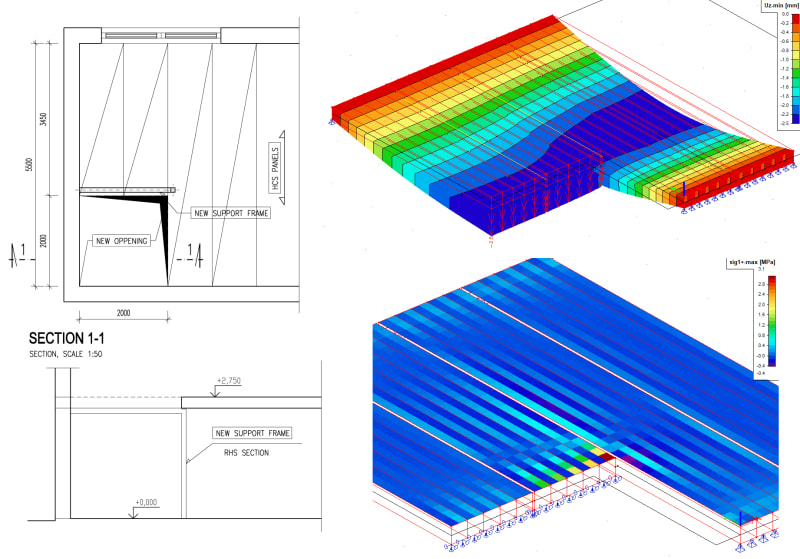CovertShear
Structural
- Nov 8, 2022
- 36
Hello everyone.
I am designing an opening in a existing hollow core slab (HCS).
Opening dimensions are 2,0 x 2,0 m (see attachment). There are no drawings for the structure, height of the section approximated 220 mm.

Luckily the owner of the property is open to installing a new steel frame support (i.e. I am not considering using a trimmer).
I have designed a similar opening in "HCS" in the past, but that one was a bit smaller.
-------------------------------------------------------------------------------------------------------------------------------------------------
My questions are :
1) Preloading of the new steel frame:
I browsed around this site for similar problems and found partial solutions that suggested preloading the supporting frame.
How would I got about doing that in reality, and should I in this case?
Whats the thinking process behind preloading a support frame?
-------------------------------------------------------------------------------------------------------------------------------------------------
2) Tensions in upper surface of HCS:
Due to the existence of a new steel support, especially near the stiff column, tension peaks jump up in the upper surface of HCS.
Is this indeed just a local peak result, or something to consider. Should one reinforce the top surface of the HCS with steel plates?
Method used: I approximated the section of a hollow core panel with a set of orthogonal 2D plates.
The grout in between panels is defined as a plate with zero bending stiffness (Iy=0 / Iz=0)
Defined a spring support in the place of steel frame to align with real life deflection.
Defined external loads.
Ran the analysis.
-------------------------------------------------------------------------------------------------------------------------------------------------
I hope my questions are not too exhausting.
Thanks in advance.
I am designing an opening in a existing hollow core slab (HCS).
Opening dimensions are 2,0 x 2,0 m (see attachment). There are no drawings for the structure, height of the section approximated 220 mm.

Luckily the owner of the property is open to installing a new steel frame support (i.e. I am not considering using a trimmer).
I have designed a similar opening in "HCS" in the past, but that one was a bit smaller.
-------------------------------------------------------------------------------------------------------------------------------------------------
My questions are :
1) Preloading of the new steel frame:
I browsed around this site for similar problems and found partial solutions that suggested preloading the supporting frame.
How would I got about doing that in reality, and should I in this case?
Whats the thinking process behind preloading a support frame?
-------------------------------------------------------------------------------------------------------------------------------------------------
2) Tensions in upper surface of HCS:
Due to the existence of a new steel support, especially near the stiff column, tension peaks jump up in the upper surface of HCS.
Is this indeed just a local peak result, or something to consider. Should one reinforce the top surface of the HCS with steel plates?
Method used: I approximated the section of a hollow core panel with a set of orthogonal 2D plates.
The grout in between panels is defined as a plate with zero bending stiffness (Iy=0 / Iz=0)
Defined a spring support in the place of steel frame to align with real life deflection.
Defined external loads.
Ran the analysis.
-------------------------------------------------------------------------------------------------------------------------------------------------
I hope my questions are not too exhausting.
Thanks in advance.
